#Poultry Market demand
Explore tagged Tumblr posts
Text
Poultry Market Is Estimated To Witness High Growth Owing To Rising Demand For Protein-Rich Food
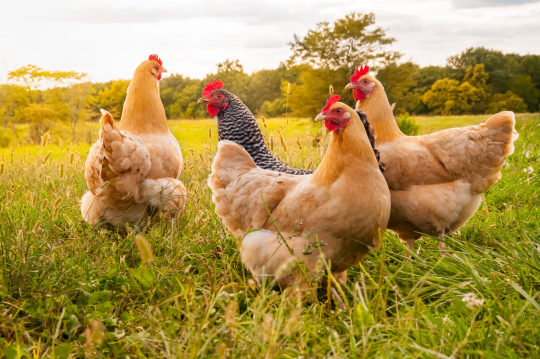
Poultry refers to domesticated birds raised for their eggs, meat, or feathers. Chicken, turkey, duck, and geese are some common types of poultry that are farmed commercially. Poultry meat is considered a rich source of protein and essential nutrients such as vitamin B3, selenium, phosphorus. It is widely consumed as a meat substitute and its products are used to prepare a variety of cuisines worldwide. The global poultry industry consists of organized commercial farms that practice large-scale contract growing and vertical integration for raising and processing birds. Adoption of advanced genetic practices, use of specialized poultry equipment and automation has helped boost productivity and meet the surging demand for affordable meat protein.
The global poultry Market is estimated to be valued at US$ 15.88 Mn in 2023 and is expected to exhibit a CAGR of 5.6% over the forecast period 2023 to 2030, as highlighted in a new report published by Coherent Market Insights. Market Dynamics: Rising demand for protein-rich food owing to rapidly growing global population is a key driver propelling growth of the poultry market. Poultry meat satisfies the nutrition requirement of protein and is much more affordable compared to alternative meat sources. According to UN data, global population reached nearly 8 billion in 2023 and is estimated to touch 9.7 billion by 2050, thus fuelling additional demand for poultry and animal protein. Furthermore, ease of poultry farming, short production cycles and higher productivity have encouraged many farmers and food processors to invest in its commercial production and associated infrastructure. This has boosted supply and availability of poultry products across geographies over the recent past. However, these practices also face sustainability challenges associated with high pollution loads, disease outbreaks, and humane treatment of farm animals. Stricter regulatory policies and compliance to environmental standards need to be maintained to ensure long term growth of the industry. SWOT Analysis Strength: - Poultry meat is a good source of high-quality protein and contains essential vitamins and minerals like selenium, phosphorus, vitamins B3 and B6. - The poultry industry provides employment to a large number of people across rural and urban areas of many countries by means of commercial poultry farms. - Countries like the United States and Brazil have developed advanced poultry farming techniques and infrastructure over the years which has helped them become global leaders in poultry production. Weakness: - Outbreaks of deadly bird flu disease can negatively impact poultry farming and trade. Strict biosecurity protocols need to be consistently followed to prevent disease spread. - Fluctuating feed costs significantly impact profit margins for poultry farmers as corn and soybean are key ingredients in poultry feed. Opportunity: - Rising global meat consumption driven by population and income growth in developing nations offers new markets for poultry exporters. - Adapting poultry farming for production of specialty high-value products like pasture-raised, free-range, and organic chicken can fetch higher prices. Threats: - Trade barriers like tariffs can restrict international trade flows of poultry meat and live birds between countries. - Spread of animal welfare activism campaigns against intensive farming practices may impact consumer demand in certain markets. Key Takeaways The global poultry market size is expected to witness high growth over the forecast period between 2023 to 2030 backed by rising global protein demand. The market size in 2024 is projected to reach US$ 15.88 Mn registering a CAGR of 5.6% during the forecast period. Regional analysis: Asia Pacific region currently dominates the global poultry market with largest production and consumption attributed to countries like China, India, and Brazil. China is the largest producer, consumer, and exporter of poultry globally. Meanwhile developed markets in North America and Europe are shifting towards specialty free-range and organic chicken segments. Key players: Key players operating in the poultry market are AstraZeneca, CorMedix, Inc., Citius Pharmaceuticals, Fresenius Medical Care, Glenmark Pharmaceuticals Ltd., Geistlich Pharma, Merck & Co., Inc., Pfizer, TauroPhar GmbH, and Xellia Pharmaceuticals Ltd. The market players are focused on expansion initiatives and implementing advanced farming technologies to further strengthen their presence across regions.
Get more insights on this topic: https://www.newsstatix.com/poultry-market-industry-insights-trends-poultry-market/
Explore more information on this topic, Please visit: https://allmeaninginhindi.com/aerial-imaging-capturing-new-perspectives-from-above/
#Poultry#Poultry Market#Poultry Market size#Poultry Market share#Poultry Market demand#Poultry Market analysis
0 notes
Text
#Saudi Arabia Poultry Feed Market#Market Size#Market Share#Market Trends#Market Analysis#Industry Survey#Market Demand#Top Major Key Player#Market Estimate#Market Segments#Industry Data
0 notes
Text
Global Poultry Diagnostics Market Is Estimated To Witness High Growth Owing To Increasing Adoption of Molecular Diagnostic Tests
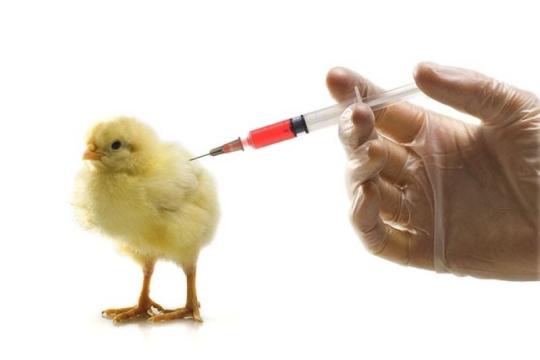
The global Poultry Diagnostics Market is estimated to be valued at US$ 536.7 million in 2023 and is expected to exhibit a CAGR of 11.4% over the forecast period 2023-2030, as highlighted in a new report published by Coherent Market Insights. Market Overview: Poultry diagnostics refer to the testing and detection of various diseases and infections in poultry farms. These diagnostics play a crucial role in preventing and managing the spread of diseases amongst poultry animals, such as chickens and turkeys. The market for poultry diagnostics is driven by the increasing demand for poultry products, rising concerns about food safety, and the need for early and accurate diagnosis of diseases to prevent economic losses for farmers. Poultry diagnostics also help in improving animal welfare and overall productivity. Market Key Trends: One key trend in the global poultry diagnostics market is the increasing adoption of molecular diagnostic tests. Molecular diagnostic tests, such as PCR (polymerase chain reaction) and DNA sequencing, offer high sensitivity and specificity in detecting and identifying various infectious diseases in poultry animals. These tests enable rapid diagnosis, identification of pathogens, and monitoring disease outbreaks. For instance, Bioingentech, a key player in the poultry diagnostics market, offers molecular diagnostic kits for avian influenza virus detection. PEST Analysis: - Political: Government regulations play a significant role in the poultry industry. Stringent rules regarding food safety and disease control drive the demand for poultry diagnostics. - Economic: The demand for poultry products is increasing worldwide due to population growth and rising disposable incomes. This fuels the need for efficient disease management through diagnostics. - Social: Consumer awareness about food safety and the importance of disease-free poultry products is growing, leading to the adoption of poultry diagnostics. - Technological: Advancements in diagnostic technologies, such as point-of-care testing and real-time PCR, are revolutionizing the poultry diagnostics market. These technologies offer faster and more accurate results. Key Takeaways: Paragraph 1: The Global Poultry Diagnostics Market Demand is expected to witness high growth, exhibiting a CAGR of 11.4% over the forecast period, due to increasing adoption of molecular diagnostic tests. These tests provide rapid and accurate detection of infectious diseases, ensuring timely disease management and prevention of economic losses for farmers. Paragraph 2: The North America region is expected to dominate the global poultry diagnostics market, primarily driven by the presence of major market players, well-established poultry industry, and strict regulations on food safety. Asia Pacific is expected to be the fastest-growing region due to the increasing demand for poultry products and the need for efficient disease management in densely populated countries like China and India. Paragraph 3: Key players operating in the global poultry diagnostics market include Zoetis, Thermo Fisher Scientific Inc., Baltivet, Bioingentech, Devex, BioChek, QIAGEN, Bioneer Corporation, Megacor Diagnostik GmbH, Merck & Co., Inc., IdentiGEN, Abaxis, BIOMERIEUX, Transasia Bio-Medicals, Boehringer Ingelheim International GmbH, EW Group Ltd., and Hygiena, LLC. These players focus on product innovation, strategic collaborations, and acquisitions to gain a competitive edge in the market.
#Poultry Diagnostics Market#Poultry Diagnostics Market Insights#Poultry Diagnostics Market Demand#Poultry Diagnostics Market Forecast#Poultry Diagnostics Market Analysis#Poultry Diagnostics Market Values#diseases#poultry farmers#healthy poultry products#Rapid diagnostic tests
0 notes
Text
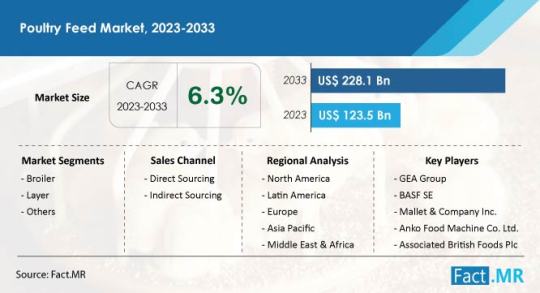
0 notes
Text
Statement on Israel’s Use of Starvation as a Weapon of War in Gaza by the Union of Agricultural Work Committees, Palestine
For five days, Israel has attacked Gaza with the aim of total destruction, and the situation is at an unprecedented level of urgency. Israel’s actions have amounted to a humanitarian catastrophe of unfathomable proportions. At the time of publication, the Palestinian Ministry of Health reports 1,055 martyrs and approximately 5,184 injured.
Israel has declared a total warfare stance on Gaza, imposing a ruthless blockade that denies over two million Palestinian residents of Gaza access to electricity, water, food, fuel, medical supplies, and any humanitarian aid. Israeli Defense Minister Yoav Gallant explicitly stated this strategy on 9 October 2023, saying: “We are imposing a complete siege on [Gaza]. No electricity, no food, no water, no fuel – everything is closed. We are fighting human animals, and we act accordingly.”
Israel’s deliberate use of starvation as a weapon of war demands the international community immediately respond with unwavering urgency and resolve.
Israel is indiscriminately decimating hospitals, schools, mosques, markets, and entire neighborhoods. Further, Israel threatened Egypt that it would bomb humanitarian aid deliveries to Gaza, prompting Egypt to withdraw its aid convoys. The Rafah Crossing into Egypt, the sole international exit from Gaza, has been bombed by Israel three times in a 24-hour period. This calculated assault severs Gazans’ only means of escape from ceaseless bombings or access to essential humanitarian aid. With Israel cutting off Gaza’s source of electricity, the only source of power was the Gaza Power Plant, which has just run out of fuel. In the case that it receives more fuel, Israel has threatened to attack the plant.
Israel’s assault is deliberately destroying any infrastructure that allows Gazans to support themselves. Vital agricultural and fishing infrastructure, crucial for food production, have been mercilessly attacked. Fisher folk cannot access the sea, into which sewage is spilling. The seaport is damaged, and tools are obliterated. Farming areas, often near the fence, have become vulnerable targets in Israeli airstrikes, and farmers whose land has not been destroyed cannot access it for daily agricultural practices. The Ministry of Agriculture reports that the bombing has done immense damage to agricultural areas and poultry farms, but the conditions make it impossible to precisely assess the situation in the field. There is a catastrophic decrease in food stocks, with shops across Gaza reporting severe shortages. The land and sea will face unimaginable environmental damages following these attacks, further preventing efforts to rebuild livelihoods.
Israel’s strategy aims to ensure that those who survive the bombs are condemned to a future without sustenance.
OCHA reports that the assaults have disrupted the UNRWA food operation, impacting at least 112,759 families. The poultry and livestock sectors are on the brink of collapse due to the severe shortage of fodder, endangering the livelihoods of more than 1,000 herders and affecting over 10,000 producers. This jeopardizes the provision of animal protein and the availability of meat and fresh sources of protein for Gaza’s entire population. Transportation of poultry to markets has virtually halted, and dairy cattle milk cannot be refrigerated nor marketed to factories, resulting in an expected daily spoilage of 35,000 liters of milk. More than 4,000 fisheries are at risk due to the closure of the sea. Gaza’s agriculture, poultry, cattle, fish, and other products are suffering from a lack of refrigeration, irrigation, incubation, and other machinery due to electricity cuts, causing spoilage.
Israel’s use of these tactics is not new by any means. Before Saturday, around 65% of the Gazan population was food insecure. More than 46% of the agricultural land in Gaza was inaccessible, and the fishing industry was severely struggling since fishing off the coast of Gaza has been restricted by Israel to 3 to 6 nautical miles.
Food insecurity is a human-made crisis, and Israel is manufacturing a mass starvation of the Gazan people.
It is the moral and legal obligation of the international community to intervene and end this crisis immediately. Food, as a basic necessity, must be allowed to reach the people of Gaza, and the deliberate targeting of civilian infrastructure must cease without delay.
We call upon the international community to take immediate action to stop Israel’s massacre of the Gazan population, demand the lifting of the siege, and establish humanitarian corridors for entry of aid.
292 notes
·
View notes
Text
Also preserved in our archive
Won't someone think of the egg prices!
By John Lindt
KERN COUNTY – The price of eggs is often used as a barometer for the economy, but this fall’s high prices are not the work of market factors, but rather migratory flights.
Avian flu is spreading along the path of birds’ southern migration for winter across California. As of Nov. 12, the U.S. Department of Agriculture (USDA) reported that a large egg ranch in Kern County has been impacted by bird flu resulting in the destruction of 2.15 million egg layers. This is the first case of HPAI in Kern County during the 2022-24 bird flu outbreak as it spread south heading into winter. Kern County is home to some of the state’s largest egg ranch operations.
The same day USDA also announced that avian flu hit two Fresno County poultry ranches, one a broiler ranch resulting in the killing of 237,700 chickens being prepped for meat and a turkey ranch requiring the destruction of 34,800 toms, or male turkeys. The news follows recent reports about avian flu spreading to Kings County poultry ranches resulting in the loss of over half a million birds and at another Fresno ranch. On Nov. 14, USDA added three more poultry ranches to the list of affected including one in Merced County, a turkey ranch with the loss of 53,200 birds and another one in Fresno County.
The locations of the poultry ranches are not far from the Pacific flyway, a major migratory route in the Western United States. In the case of Kern County, the egg ranch was close to the Kern Wildlife Refuge as well as nearby dairies. This is worrying observers that there appears to be a connection between all three vectors for the rapidly mutating virus.
Northern California poultry operations have been hard hit as well. Nationwide, outbreaks have claimed more than 21 million hens, so far in 2024.
Egg Prices In California the impact on egg prices has been significant.
On Nov. 13, the USDA reported that a dozen large, white cage-free eggs cost about $5.26 per dozen in California. This is according to USDA market data for the week of Nov. 8. USDA says this is a “benchmark” price. The price is up from $2.81 a month earlier. That is almost double the benchmark, but may not reflect retail.
The last time California eggs were this high was in February when California egg prices – cage-free egg prices – peaked at $5.59 per dozen.
The cases of infected birds correspond with fall bird migrations that are spreading the virus throughout the state. Detections are higher in fall and spring as wild birds spread the virus when they migrate. This year the bird flu has taken its toll with the outbreak of H5N1, a highly transmissible and fatal strain of avian influenza, or bird flu. The outbreak started in early 2022 and rapidly grew into the largest bird flu outbreak in U.S. history.
Most recently, outbreaks affecting more than 2.84 million egg layers were reported in October at commercial facilities in Oregon, Washington and Utah, according to the Centers for Disease Control and Prevention (CDC).
As of Nov. 8, the virus has affected over 105.2 million birds in the U.S. since January 2022, according to the CDC. The California egg shortage will likely have a pocketbook impact on holiday baking activity as the nation prepares for Thanksgiving; however, a recent USDA analysis suggests consumers may not see a huge jump.
“Large volume grocery retailers across the nation have launched their shell egg feature campaigns targeting holiday demand at relatively attractive price levels. Much of this is attributable to changes in the way shell eggs are being marketed with an increasing share (estimated at over half of all shell egg volume sold at retail) tied to production cost agreements not prone to fluctuation common in formula trading.”
There are about 378.5 million egg-laying chickens in the US. As of last year, there were 9.4 billion broiler chickens and 218 million turkeys processed, according to the USDA. Advocates note the high cost of the influenza just in the egg market. “With domestic sales of shell eggs and products amounting to seven billion dozen, consumers paid an incremental $15 billion as a result of the prolonged and uncontrolled infection.”
While bird flu is impacting poultry farms, another strain of the virus has impacted Central Valley dairies as well, spreading quickly since September to 291 dairy farms as of press time. Unlike poultry, dairy cows typically survive the virus, although milk production is expected to be impacted.
Avian flu is a worldwide phenomenon. In the past two weeks, the first cases of highly pathogenic avian influenza (HPAI) of the fall season have been reported in Albania, Great Britain, Romania, and now regions of Germany and Ukraine.
Despite the increase in US egg prices this holiday season, turkey prices are down from last year when supply was also affected by bird flu. Across the country, a 15-pound turkey costs an average of $31.16 ($2.08 per pound) in 2024, compared with $35.40 ($2.36 per pound) in 2023. That price reduction represents a price decrease of 12% from last year to now,” a report said. The lower price comes even as a U.S. Department of Agriculture report showed turkey production dipped more than 6% compared to this time last year.
Hen and Hoof The spread of this strain of the virus appears to be affecting both the Central Valley poultry and dairy industries at the same time.
Just before Sept. 1 there were no reports of the virus in the Valley’s dairy industry. But as of Nov. 15, there are almost 300 diaries, mostly in Tulare and Kings Counties, impacted with new ones being added every day.
The Valley poultry industry has been on a similar viral timeline which coincides with the annual bird migration along the Pacific flyway that happens each fall. H5N1 largely infects wild birds, with waterfowl such as ducks and geese being the natural reservoirs for H5N1 viruses. Most H5N1 viruses are highly pathogenic avian influenza, meaning spillovers into other bird populations can lead to high mortality rates, including domesticated poultry.
A compounding factor for the spread of the virus is that both livestock are often on land located right next door or just down the road. The Central Valley is home for both industries with animals, transported in and out, and service vehicles going in and out of these large facilities every day.
The industry website Egg-News this week pointed out that research shows that the infections can be transmitted over a distance of up to a mile while attached to dust particles. Fall is harvest for a number of crops, including the nut industry, sending up plumes of dust in the Valley sky, at times associated with winds.
Egg-News points out that dairy cow-associated H5N1 viruses have jumped back into wild birds, and recent outbreaks in domestic poultry resembled H5N1 in dairy cows.
In an editorial Egg-News said “APHIS Needs a New Approach to Control HPAIr.” They recommend that USDA’s Animal and Plant Health Inspection Service (APHIS) adopt vaccination as a disease control strategy for bird flu, with promising results from clinical trials. In May 2023, the U.S. authorized the vaccination of California condors against a type of avian flu.
Also, the USDA has approved field trials to test vaccines that could prevent dairy cows from getting the H5N1 strain of bird flu. The USDA approved the first field trials for the vaccine in September 2024. The USDA’s Center of Veterinary Biologics (CVB) is overseeing the trials. At least 24 companies are working on the vaccine, including Zoetis and Merck Animal Health.
If vaccines can save the U.S. poultry and dairy industry over the next year, the industry may have to worry about who heads up the U.S. Department of Health and Human Services (HHS), the agency which authorizes vaccines for animals and humans. Nominee Robert F. Kennedy, Jr. has made it clear he is anti-vaccine but has yet to comment on the use of vaccines in agriculture if he is confirmed for the role.
34 notes
·
View notes
Note
You’ve probably gone over this before but tumblr’s search engine sucks butt. So, what would each culture’s staple crops and livestock (for both meat and byproducts) be? How much would globalization come into play, like how irl potatoes are originally from South America but have become one of the most important staple foods across the world?
Staple crops and livestock vary throughout the Provinces due to climate and geography, though trade over the centuries has meant that ingredients like saltrice from Morrowind and honey from Skyrim are in constant circulation around the continent. Nonetheless, here are some uniquely local ingredients you'll find across Tamriel.
Altmer
Summerset's temperate climate makes it the ideal place to grow all sorts of exotic fruit, especially stone fruit. From peaches to lychees, nectarines to cherries, Summerset produces the largest quantities of these fruits (with the trade embargo around the Great War and Dragon Crisis making them an extremely sought-after prize). And don't forget the wine! Summerset is also famed for its gorgeous vineyards and even more gorgeous wines. However, juicy and flavourful grapes are beloved by almost anybody, making them a valuable staple crop too.
Livestock in Summerset is nothing particularly exciting. Merino sheep are farmed for their wool, which is a luxury export beloved by northern Provinces, while meat comes in the form of cattle and chickens. However, High Elves particularly love their wild-caught fish and herons, which are populous on their home island.
Argonians
Once again, fruit is a major export from Black Marsh, but the fertile (if hostile) region is home to some of Tamriel's best agricultural soil. From cocoa and coffee beans, saltrice and coconuts, to padan and banana leaves and more, you'll find all sorts of wonderful plant-based ingredients in Black Marsh. However, something that has gained in popularity following the Argonian diaspora has been palm wine, a potent alcoholic beverage.
As for livestock, you'll find bantam guar, guar lizards, various poultry, goats, and even farmed frogs and lizards to be popular. Sheep and cattle are far less popular due to the upkeep required for them to stay healthy in the swampy environment, making beef and mutton less popular and more expensive than in other Provinces.
Bosmer
The Bosmer are famed for their meat and animal byproducts, particularly from timber mammoths and sugar mammoths. Whether it's meat, pelts, or milk, these beasts are much beloved by the Wood Elves who take great care in rearing them.
Other popular exports from Valenwood include alcoholic beverages like rotmeth and jagga, as well as kopi luwak- a luxurious type of coffee made from beans found in civet cat excrement, thus making them Green Pact-friendly. And of course, Valenwood produces some of Tamriel's finest cocoa beans, mostly used for export. However, have you truly lived until you've tried salted sugar mammoth caramelised milk chocolate from Woodhearth?
Bretons
In High Rock, sheep and cattle are the most popular livestock to farm due to their versatility, with a constant demand for their meat, horns, skins, and milk. While it's nothing exciting, the animals in the region are usually grass-fed and free range, spanning acres of farmland (which can sometimes result in cultists and the like infringing upon the livelihood of livestock). Chickens, geese, turkeys, and ducks are also popular for their meat, down, and eggs, with High Rock producing some of Tamriel's best duck meat.
With regards to staple crops, wheat is a major export and features heavily in Breton cuisine, especially in bread.
Dunmer
The volcanic ash of Morrowind is key to its success in growing all manner of weird and wonderful crops. Market stalls across Vvardenfell and Blacklight bustle with sellers touting mushrooms of all kinds, saltrice, comberry, marshmerrow, hackle-lo, canis root, and much more, all of which are consumed locally as well as across Tamriel.
Regarding livestock, it should come as no surprise that the big money is in bug farming. Kwama mines produce cuttle, scuttle, scrib jelly, and kwama eggs, making them the backbone of Morrowind's mages and chefs alike. Nix-hounds and guar are raised both by town Dunmer and Ashlanders, while wild nix-ox is also popular for those who can afford it.
Imperials
Cyrodiil spans terrain from the snowy Jerall Mountains to the swamps of Blackwood. As a result, the Province is relatively self-sufficient in that it produces the bulk of its own consumption, from livestock to greens. Speaking of greens, battaglir, a type of weed, is a staple in the Imperial diet, making wild-foraged and farmed battaglir a key crop in the region. Like Summerset, Cyrodiil is also famed for itswines, and is proud of its unique grapes of every size, flavour, and colour (including ones that taste like cotton candy).
Livestock in Cyrodiil is about as generic as can be: cows, sheep, goats, poultry, and horses. While meat is a staple part of the Imperial diet, milk is also important as it is used to make the cream and cheeses so prized by the Province.
Khajiit
What don't the Khajiit grow or rear? From Southern Elsweyr's rich moon sugar and rice paddies to the North's edible cacti and tea, the Province is full of exotic and scrumptious delights that are highly prized across Tamriel. Ingredients are valuable both raw and processed, and form the backbone of the Khajiiti economy. Samar Pekoe tea, for example, is wild-harvested from caves and is beloved by tea aficionados across the continent, and fetches a hefty price for its rarity. Pellitine cacao and coffee beans are also a staple in any self-respecting chef's kitchen.
In terms of livestock, you'll find guar, poultry, beef, and goat to be popular, as well as wild game like jerboas, terror birds, antelope, and addaxes. Game meat can often be purchased from Bandaari nomads, who hunt the animals themselves. Whether fresh or dried into jerky, who doesn't want some moon sugar-cured addax jerky for the road?
Nords
Foreigners in Skyrim are often shocked by the range of produce we're capable of producing in our cold and often inhospitable lands. Fish and horker are consumed in great amounts locally, as well as being one of the Province's major exports. Goat from the Reach, cattle from Whiterun, and honey from the Rift are always in high demand.
Apples and jazbay grapes are probably the most valuable crops in Skyrim, followed by wheat and other fruits and vegetables. The former two are used in cider and wine, both of which are valued across the Provinces.
Orcs
Wrothgarian Orcs differ from Betnikh Orcs who differ from Wood Orcs and so on... so in this case, it really varies. For Wrothgarian Orsimer, echatere is the main source of meat and milk, while in Betnikh it's fish, and in Valenwood, timber mammoth. All these groups also enjoy game, from rabbit and wolf to pheasant and venison, which features heavily in regional Orcish cuisine. Wild honey from Betnikh is also another notable animal product that bears mention here.
In terms of crops, there aren't many of note aside from valuable herbs and spices. Frost mirriam, which is also loved by alchemists, and wrathberries, known for their violently bitter taste unless prepared correctly, are two of the most important plants you'll find for sale at any stronghold.
Redguards
I've said it before and I'll say it again: goat, goat, and more goat. Unless you're a coastal Redguard with access to seafood, it's likely that your main source of meat and milk will come from goats. Whether it's feta or kebabs, it's almost always goat meat, as they wander all through Hammerfell like they own the place. However, Redguards are also renowned for breeding horses, and the uh... faulty ones are generally turned into food. Spiced horse blood sausage and spreadable horse 'nduja are a staple in households across Hammerfell.
With staple crops, you'll find that corn, coconuts, palm fruit and oil, bananas, coffee, cinnamon and other spices, and cocoa are plentiful. These are all consumed in great amounts within the Province, but are also highly prized across Tamriel.
77 notes
·
View notes
Text
Excerpt from this story from DeSmog Blog:
With its unparalleled purchasing power and exacting demands, fast food has long shaped agricultural systems in the United States, Europe, and China. But as major American fast food brands, like KFC, expand into so-called “frontier markets,” taxpayer-funded development banks have made their global expansion possible by underwriting the factory farms that supply them with chicken, a DeSmog investigation has found.
In all, the investigation identified five factory-scale poultry companies in as many countries that have received financial support from the International Finance Corporation (IFC, the private-sector lending arm of the World Bank Group), the European Bank for Reconstruction and Development (EBRD), or both since 2003, and that supply chicken to KFC. A sixth company has benefited from IFC advisory services but has not received financing.
A review of press accounts, financial disclosures, and the companies’ websites shows this support aided these firms’ KFC-linked operations in up to 13 countries in Asia, Africa, and Europe.
In Kazakhstan, both banks helped a Soviet-era poultry factory become a KFC supplier. In 2011, the IFC lent poultry company Ust-Kamenogorsk Poultry (UKPF) invested $2 million in refurbishing housing for chickens, among other projects. In 2016, the EBRD made a $20 million equity investment in the company’s parent, Aitas, to finance the construction of a new facility to raise and process poultry. In 2018, two years after announcing the financing deal, UKPF revealed it had become a supplier to KFC in Kazakhstan. The EBRD sold its stake in the company in 2019.
In South Africa, the IFC helped one KFC supplier bolster its operations across the region. In 2013, the bank loaned Country Bird Holdings $25 million to expand existing operations in South Africa, Botswana, and Zambia. Country Bird supplies KFC in all three countries, as well as Mozambique and Zimbabwe. Three years later, in 2016, Country Bird also became KFC’s sole franchisee in Zambia.
In Jordan, the EBRD’s technical support and a 2015 loan worth up to $21 million helped poultry company Al Jazeera Agricultural Company upgrade its facilities and expand its retail presence. Al Jazeera claims to produce half the country’s restaurant-sold chicken. It includes the local franchisees of KFC and Texas Chicken (known by its original name, Church’s Chicken, in the U.S.) as clients.
With this Global North-financed fast-food expansion comes a host of environmental, social, and health concerns in regions often unprepared to field them.
“It’s so clear that these investments are not consistent with any coherent notion of sustainable development,” Kari Hamerschlag, deputy director for the food and agriculture program at Friends of the Earth US, told DeSmog.
Providing Financial Security for Fast Food Suppliers
Both the IFC and the EBRD are financed primarily by the governments of developed countries for the benefit of developing countries. The IFC was founded in 1956 under the umbrella of the World Bank Group to stimulate developing economies by lending directly to businesses. Founded in 1991, the EBRD was formed to support Eastern Europe’s transition to a market economy. Since then, it has extended its geographic reach to include other regions.
Development banks often finance companies and projects in regions that more risk-averse commercial banks tend to avoid. The idea is to help grow a company’s operations and lower the risk for private sector investors.
Both of these development banks’ investments cover a range of sectors, including manufacturing, education, agribusiness, energy, and tourism. Because large agro-processors, such as poultry companies, can transform bushel upon bushel of local crops into more valuable products, like meat, they make especially attractive clients.
The world’s largest restaurant company, U.S.-based Yum! Brands, owns KFC, and calls the fried chicken powerhouse, which oversees more than 30,000 locations across the globe, a “major growth engine.”
6 notes
·
View notes
Text
Valves Market is Estimated to Witness High Growth
Valves Market is Estimated to Witness High Growth Owing to Rising Constructional and Infrastructure Development Activities The valves market comprises products such as gate valves, globe valves, check valves, butterfly valves, ball valves and pressure regulating valves which are used to control the flow, pressure and direction of fluids. Valves are extensively used in power plants, refineries, oil & gas, water & wastewater and construction activities. These products play a key role in fluid transportation and management which makes them an integral component across various industrial sectors. Rising infrastructure development projects across both developed and developing nations are augmenting the demand for valves. Moreover, growing pipeline networks for oil & gas transportation is also favoring market growth. The Global valves market is estimated to be valued at US$ 83 Mn in 2024 and is expected to exhibit a CAGR of 3.5% over the forecast period 2024 To 2031. Key Takeaways Key players operating in the valves market are Tyson Foods, Inc., JBS S.A., Pilgrim's Pride Corporation, Wens Foodstuff Group Co. Ltd., BRF S.A., Perdue Farms, Sanderson Farms, Baiada Poultry, Bates Turkey Farm, and Amrit Group. The major players are focusing on capacity expansion plans and mergers & acquisitions to gain market share. Rising population and changing diets are expected to fuel the growth of the poultry sector which presents significant opportunities for valve manufacturers. With the growing poultry industry, demand for processing equipment including valves is also projected to rise substantially over the forecast period. The global valves market is estimated to witness growth across key regions such as North America, Europe, Asia Pacific, Latin America, and Middle East & Africa. This can be attributed to surging investments in oil & gas, water & wastewater infrastructure, and industrial development projects worldwide. Emerging economies with high urbanization rates like China and India also offer lucrative prospects for market expansion. Market Drivers The key driver behind the Valves Market Demand is the increasing constructional and infrastructure development activities worldwide. There is huge government focus as well as private investments toward projects such as roadways, railways, metro stations, power generation, water supply, etc. which involves extensive use of valves in various process applications. Further, the rising need for energy and growing focus on rural electrification has boosted investments in power transmission and distribution sector augmenting valves demand.
PEST Analysis
Political: The valves market is regulated by laws pertaining to safety, environmental protection and quality standards. New regulations regarding emissions could impact demand patterns. Economic: Changes in the global and regional economic conditions directly impact spending on industries like oil & gas, energy & power, and water & wastewater management which influences Valves demand. Social: Growing population and urbanization is increasing requirements for water, energy and other infrastructure development which boost the usage of valves. Technological: Advancements in materials and designs of valves are improving efficiency, lowering costs and enabling usage in newer applications. Digitalization is also aiding remote monitoring of industrial valves. The regions concentrating maximum valves market share in terms of Valves Market Size and Trends include North America, Europe and Asia Pacific. North America accounts for a major portion owing to strong presence of end-use industries like oil & gas and significant infrastructure spending. Europe and Asia Pacific are also sizable markets led by Germany, China, India respectively. The fastest growing regional market for valves is expected to be Asia Pacific led by increasing investments in water & wastewater management, power projects and industrial activities in China and India. Rising standards of living and initiatives to improve urban infrastructure will further drive the demand across developing nations in the region.
Get more insights Valves Market
Discover the Report for More Insights, Tailored to Your Language.
French German Italian Russian Japanese Chinese Korean Portuguese
About Author:
Ravina Pandya, Content Writer, has a strong foothold in the market research industry. She specializes in writing well-researched articles from different industries, including food and beverages, information and technology, healthcare, chemical and materials, etc. (https://www.linkedin.com/in/ravina-pandya-1a3984191)

#Coherent Market Insights#Valves Market#Control Valves#Globe Valves#Plug Valves#Gate Valves#Ball Valves#Butterfly Valves
2 notes
·
View notes
Text
Exploring the future of organic fertilizer makers: the key to sustainable agriculture
Organic fertilizers are becoming increasingly important in modern agriculture. As an environmentally friendly and sustainable solution, organic fertilizers not only improve soil fertility, but also reduce the use of chemical fertilizers, which is important for environmental protection. Today, we will take an in-depth look at the innovative technology of the Organic Fertilizer Maker to see how it contributes to sustainable agriculture and, in particular, the contribution of the LANE Group in this field.
What is an organic fertilizer maker? An organic fertilizer maker is a machine designed to convert various organic wastes into organic fertilizers. These wastes include livestock and poultry manure, straw, garden waste, etc. Through a series of treatment processes, these wastes are converted into nutrient-rich organic fertilizers for crops.

Working Principle of Organic Fertilizer Making Machine The working principle of organic fertilizer manufacturing machine mainly includes the following steps:
Raw material collection: various organic wastes are collected. Crushing treatment: Crush the large pieces of waste into small particles through the crusher for subsequent processing. Fermentation treatment: the crushed waste is piled up and fermented to decompose it into organic fertilizer through the action of microorganisms. Drying and granulation: The fermented organic fertilizer is dried and then made into granules by a granulator for easy storage and use. LANE Group's organic fertilizer production line

LANE Group is a leader in the field of organic fertilizer manufacturing machines, and its production lines have significant advantages in terms of technology and efficiency. Below are some of the key features of LANE Group's lines:

High-performance equipment: LANE Group's organic fertilizer manufacturing machines are equipped with the latest technology to ensure high production capacity and stable operational performance. Fully automated operation: The production line is equipped with a fully automated control system, which automates the entire production process from raw material handling to the final product, greatly reducing labor costs. Environmentally friendly design: LANE Group focuses on environmental protection, and each piece of equipment has been strictly designed for environmental protection to ensure that the impact on the environment is minimized during the production process. Customized service: According to the specific needs of customers, LANE Group can provide customized production line design and solutions to meet the needs of different scales and types of organic fertilizer production.
Advantages of Organic Fertilizer Manufacturing Machine Environmental protection: Using organic waste to manufacture fertilizer reduces the accumulation of waste and pollution to the environment. Improve soil fertility: organic fertilizers are rich in organic matter and trace elements, which can improve soil structure and enhance the soil's ability to retain water and fertilizer. Reduce costs: Compared with chemical fertilizers, organic fertilizers are widely available and inexpensive. Improve crop yield and quality: long-term use of organic fertilizers can improve crop yield and quality, and enhance its resistance to pests and diseases. Development prospect of organic fertilizer manufacturing machine With the global emphasis on sustainable agriculture, the market demand for organic fertilizer manufacturing machines is increasing. More and more farmers and agribusinesses are beginning to realize the advantages of organic fertilizers and are gradually adopting organic fertilizer manufacturing machines for their production.LANE Group has become a key player in the market by virtue of its advanced technology and quality services. In addition, government policy support and subsidy measures also provide a strong guarantee for the development of organic fertilizer manufacturing machines.
Organic fertilizer manufacturing machine, as an innovative agricultural technology, is gradually changing the production method of traditional agriculture.LANE Group has made remarkable achievements in this field with its high performance, full automation, environmentally friendly design, and customized services. It not only provides farmers with an environmentally friendly and efficient fertilizer solution, but also makes an important contribution to the development of sustainable agriculture. In the future, with the continuous progress and promotion of technology, the organic fertilizer manufacturing machine will surely play an even more important role in the agricultural field.
Contact Us!

2 notes
·
View notes
Photo


“Food has now taken a dominant position in the war, and we must ask the American people to sacrifice far more than was at first thought necessary.” Herbert Hoover, U.S. Food Administration, 12/1/1917.
Record Group 4: Records of the U.S. Food Administration
Series: General Correspondence
File Unit: No. 36 -Window Cards & Home Cards
Transcription:
United States Food Administration ADDITIONAL DIRECTION TO FIRST HOME FOOD CARD Read again your original Home Card. If you have lost it, apply for another, to the Federal Food Administrator for your State.
The Food Administration, aside from those general directions, asks everyone to maintain rigidly a minimum of at least:
ONE WHEATLESS day each week and one WHEATLESS MEAL each day; the wheatless day to be Wednesday. By wheatless we mean to eat no wheat products.
ONE MEATLESS day each week which shall be Tuesday and one meatless meal each day. By meatless we need to eat no red meat — beef, pork, mutton, veal, lamb; no preserve the meat — beef, bacon, ham or lard.
ONE PORKLESS day each week in addition to Tuesday, which shall be Saturday. By porkless we mean no fresh or salted pork, bacon, lard or ham.
SUGAR. — You can materially reduce sugar by reducing the use of candy and sweet drinks. We will make every endeavor to see that the country is provided with a supply of household sugar on the basis of three pounds of sugar for each person per month. Do not consume more.
HUMAN FOODSTUFFS COMPRISE THREE PRINCIPAL ELEMENTS:
PROTEIN: Mainly present in meat, bacon, fish, poultry, milk, and to some extent in grains.
FATS: That is, butter, cream, lard, bacon, margarine, cooking fats, beans, cottonseed oil and other vegetable oils.
CARBOHYDRATES: Grains, sugar, potatoes and other vegetables.
As a nation we eat and waste 80 percent more protein than we require to maintain health. Therefore, we can reduce the amount of meat we eat without harm.
We eat and waste 240 percent more fat than is necessary.
Of the carbohydrates we can just as well consume corn, oats and the other cereals as wheat and we have abundant supplies of potatoes and vegetables.
Do not limit your supplies of milk and table butter, but consume it all. Don't waste any.
You can reduce the consumption of fats by reducing pastry and fried foods.
Remember the gospel of the clean plate, the serving of small portions, the purchase of less supplies.
HOARDING. — Any person in the United States who buys more foodstuffs than he customarily keeps at home in peace times is defeating the Food Administration and his purpose to secure a just distribution of food and its great endeavors to reduce prices. The hoarding of food in households is not unnecessary, as the Government is protecting the food supply of our people, but it is selfish and is a cause of high prices.
Such actions multiplied by thousands increase the demands upon our railways for cars and already, because of our military demands, it is with extreme difficulty we can now move the vitally necessary food to markets.
There is much insidious propaganda in the country against conservation and increase production. All opposition to these services is direct assistance to the enemy.
[page 2]
UNITED STATES FOOD ADMINISTRATION FOR WISCONSIN OFFICIAL BUSINESS PENALTY FOR PRIVATE USE TO AVOID RETURN AFTER 5 DAYS TO PAYMENT OF POSTAGE, $300 STATE CAPITAL To Members of the United States Food Administration:
The food situation in Europe is far greater than when the preliminary survey of the food supply of the world for this year was made. We have an abundance for ourselves, and it is the firm policy of the Food Administration, by the prevention of exports, to retain for our people an ample supply of every essential foodstuff. The harvest of our Allies have proved less than we had contemplated, and the great curtailment of shipping by the submarines during the last few months has further prevented them from access to more remote markets. Beyond the demands of the Allies there is a call upon us by the friendly neutral for food supplies, and if we cannot at least in parts respond to these neutral calls, starvation on an unparalleled scale must ensue.
Food has now taken a dominant position in the war, and we must ask the American people to sacrifice far more than was at first thought necessary. We have exported the whole of the surplus of the wheat from the harvest after reserving to ourselves an amount sufficient for our normal consumption of seed and flour until not the next harvest, and therefore the amount of wheat flour that the United States can contribute to mix with the war bread of our Allies during this winter will be simply the amount that our people reduce their consumption month by month. In other words, every grain of wheat or its products that the Allies received from the United States from now on will be exactly the amount which our people have save each month on their behalf.
The Allies today ask for 25 per cent more meat and fats (pork, dairy products and vegetable oils) then we consider our monthly production permits us to send them without trenching on our own supplies, or, on the other hand, unless we can consume less. Due to the shortage in shipping, our available sugar supplies must be less than normal from the present time forward.
Thus every particle of diminished consumption by the American people is one particle more for the soldiers, men, women and children of our Allies and for the starving people in other countries. This is a personal obligation upon every one of us towards some individual abroad who will suffer privatization to the extent of our own individual negligence.
If we are to reduce the consumption of the few products which we should export abroad, we will need to eat a larger proportion of many different foodstuffs which we cannot export in which we have at home. For this reason we MUST NOT waste ANY foodstuffs. A great many individuals in our population need far more food than is necessary to maintain their health and strength. In this emergency only the simplest of living is patriotic. We want no person in the United States to be less than is required for good health and strength, or in this emergency America requires every atom of the productive power of our people. While many can eat less, all of our population can substitute other foodstuffs for the few that are vitally needed for export.
We must not overlook the fact that Russia collapsed not because of the Germans on her borders but largely because of the failure to organize and feed her own citizens, and, if we are to emerge victorious from this war, we cannot risk the collapse of another of our allies from this same cause. There is no waste of food among any of our allies — there is the most drastic reduction in their consumption; there is actual privation among their women and children; there is starvation in Belgium.
We have already issued a series of suggestions in the Home Card - a card that is now hanging in over ten millions of homes. These suggestions have already shown important results, and to these we now add others. The problem of saving and food is a local and individual one, so that more precise and definite rules just to all cannot be formulated. It is a matter for the conscientious consideration of every individual that he or she should eat only that which is necessary to maintain bodily health and strength and unselfishly to select those foodstuffs the use of which relieves international necessities. In this winter of 1918 lies the period when there will be tested in this great free country of ours the question as to whether or not our people are capable of voluntary individual self-sacrifice to save the world.
HERBERT HOOVER, Washington, December 1, 1917. United States Food Administrator.
#archivesgov#December 1#1917#1910s#WWI#World War I#Herbert Hoover#food#historical food science#rationing
48 notes
·
View notes
Text
The plight of Kenya's jobless youth: A story of hope and despair.
By Emmanuel Okiru, 17 November 2023
Kenya is facing a serious challenge of youth unemployment, which affects millions of young people who are either out of work or stuck in low-quality and informal jobs. According to the World Bank, the youth unemployment rate in Kenya was 13.35 percent in 2022, among the highest in the world. The situation is worse in urban areas, where the youth unemployment rate was 19.1 percent in 2009, the latest year for which data is available.
The causes of youth unemployment are complex and multifaceted, ranging from a slow-growing economy, a mismatch between the skills of the labor force and the demands of the market, a lack of access to capital and credit, and a high population growth rate that outstrips the creation of new jobs. Moreover, the COVID-19 pandemic has exaggerated the problem, as many businesses have closed down or reduced their operations, leading to massive layoffs and income losses.
However, despite all these, there are also stories of hope and resilience among the Kenyan youth who are trying to overcome the barriers and create opportunities for themselves and others. Some of them have benefited from various initiatives and programs that aim to provide them with skills, training, mentorship and funding to start and grow their own businesses or find decent employment.
One such program is the Youth Enterprise Development Fund (YEDF), which was established by the government in 2006 to support youth entrepreneurship and innovation. The fund offers loans, grants and business development services to youth groups and individuals who have viable business ideas or existing enterprises. According to the fund's website, over 12 billion Kenyan shillings has been disbursed to more than 1.4 million youth since its inception.
One of the beneficiaries of the YEDF is Mary Wanjiku, a 24-year-old who runs a poultry farm in Kiambu County. She started her business in 2019 with 100 chicks, after receiving a loan of 50,000 shillings from the fund. She has since expanded her farm to 500 birds and sells eggs and chicken to local hotels and supermarkets. She has also employed two other young people to help her with the daily operations.
"I am very grateful to the YEDF for giving me this opportunity to start and grow my business. It has changed my life and given me a sense of purpose and dignity. I am able to support myself and my family, and also create jobs for other youth in my community," this is what she had to say in an interview with the Kenyan disclosure team.
This is just an example of how some Kenyan youth are coping with the challenge of unemployment and how some programs are trying to address it. However, there is still a lot that needs to be done to create more and better opportunities for the millions of young people who are still struggling to find their place in the society and the economy.
YEDF Testimonial video. Source: https://m.facebook.com/StateHouseKenya/videos/short-video-youth-enterprise-development-fund-yedf-beneficiaries/891250118940038/?locale=ms_MY
Photo gallery depicting the state of Unemployment in Kenya.

Kenyan youth protesting over increased unemployment. Source; Business Daily Newspaper, 2020.

Jobseekers wait to hand in their documents during recruitment at County Hall in Nairobi
Source; Nation Media Group, 2019.

Job seekers queuing for interviews in Nairobi. Source; The East African Newspaper.

Kenyan doctors protest against unemployment. Source; https://www.aa.com.tr
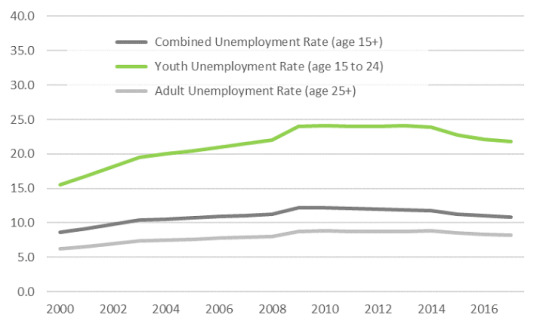
Unemployment rate in Kenya over the years.
The graphs below give a clear depiction of Kenya's state of employment over the years;
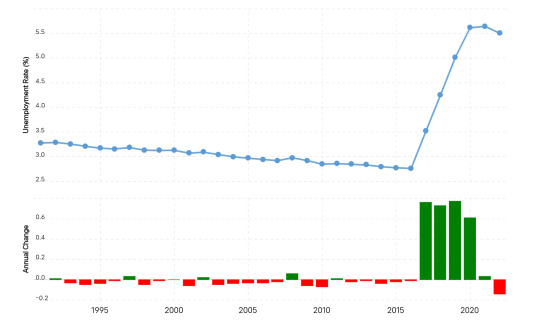
Source: <a href='https://www.macrotrends.net/countries/KEN/kenya/unemployment-rate'>Source</a>
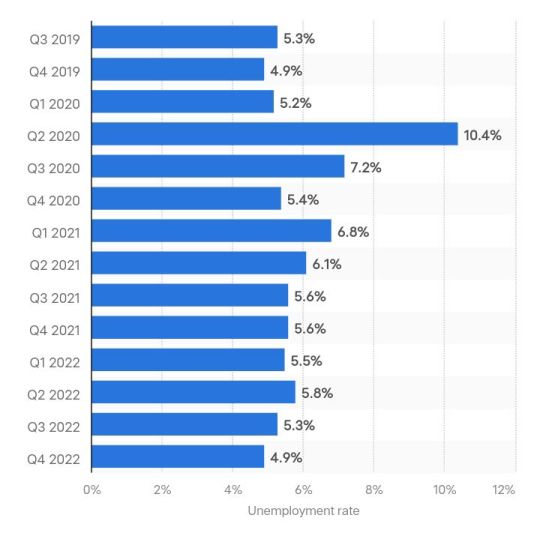
Unemployment rate in Kenya from Q3 2019 to Q4 2022. Source; https://www.statista.com/statistics/1134370/unemployment-rate-in-kenya/
2 notes
·
View notes
Text
Global Poultry Antibiotic Market Is Estimated To Witness High Growth Owing To Rising Concerns Regarding Poultry Health

The Global Poultry Antibiotic Market is estimated to be valued at US$ 3.45 billion in 2022 and is expected to exhibit a CAGR of 5.8% over the forecast period 2023-2030, as highlighted in a new report published by Coherent Market Insights. Market Overview: The Poultry Antibiotic Market refers to the market for antibiotics used in the poultry industry to prevent and treat various infections and diseases in poultry. Poultry antibiotics play a crucial role in ensuring the health and well-being of poultry, as they help in preventing and controlling diseases that can cause significant economic losses for poultry producers. Poultry antibiotics have several advantages, including improved feed conversion ratios, increased growth rates, enhanced disease resistance, and reduced mortality rates. These antibiotics help maintain the overall health of poultry and improve their productivity, thereby benefiting both the poultry industry and consumers. Market Key Trends: One key trend observed in the Poultry Antibiotic Market is the increasing demand for antibiotics derived from natural sources. As consumers are becoming more conscious about food safety and animal welfare, there is a growing preference for natural or organic products. This trend has led to the development and utilization of antibiotics derived from natural sources, such as plant extracts, essential oils, and probiotics. For example, companies like Zoetis Inc. and Elanco Animal Health are investing in research and development to develop antibiotics with natural origins. These antibiotics offer similar efficacy to synthetic antibiotics but are considered safer and more sustainable. PEST Analysis: - Political: Regulatory frameworks regarding the use of antibiotics in animal feed vary across different countries. Some countries have banned the use of certain antibiotics as growth promoters, while others have implemented stricter regulations on antibiotic use in animal husbandry. - Economic: The demand for poultry products is increasing globally, driven by population growth and rising disposable incomes. This creates a favorable market for poultry antibiotics as producers strive to meet the growing demand. - Social: Increasing concerns about food safety and animal welfare have led to a greater focus on reducing the use of antibiotics in animal feed. Consumers are becoming more conscious of the potential risks associated with antibiotic residues in poultry products. - Technological: Advancements in biotechnology and genetic engineering have paved the way for the development of alternative antibiotic strategies, such as vaccines and phage therapy. These technologies are expected to reduce the reliance on antibiotics in the future. Key Takeaways: Paragraph 1: The Global Poultry Antibiotic Market Size is expected to witness high growth, exhibiting a CAGR of 5.8% over the forecast period. This growth can be attributed to increasing concerns about poultry health and the need to prevent and treat diseases effectively. For example, outbreaks of avian influenza and other infectious diseases have highlighted the importance of proper disease management in the poultry industry. Paragraph 2: Asia-Pacific is expected to be the fastest-growing and dominating region in the Poultry Antibiotic Market. The region has a large population, increasing disposable incomes, and a growing demand for poultry products. Furthermore, countries like China and India have substantial poultry production and are investing in modern poultry farming practices, driving the demand for antibiotics.
#Poultry Antibiotic Market#Poultry Antibiotic Market Demand#Poultry Antibiotic Market Outlook#Poultry Antibiotic Market Analysis#Poultry Antibiotic Market Overview#Poultry Antibiotic Market Insights#Poultry Antibiotic#poultry farming#bacteria#vaccination#probiotics#active pharmaceutical ingredients#Coherent Market Insights
0 notes
Text
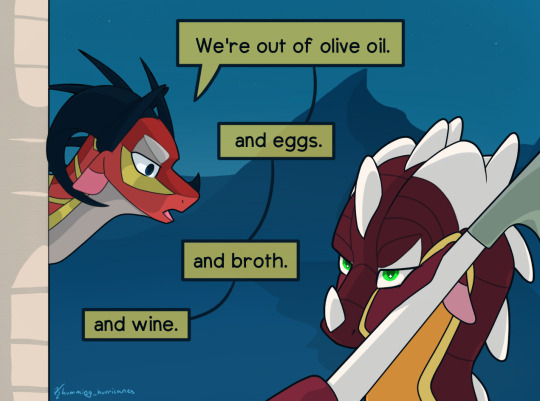
lore post!!
infodumping under the cut
So Concorde (brooding one on the right) and Albu (left) live in this place called Hesti. (Or more specifically, they live in an outpost in the middle of nowhere on the farthest border of Hesti.) This post is about Hesti's economy. And I'm not talking about stock prices or gross domestic product; I mean economy in its most basic anthropological form: how food is acquired and distributed to a culture.
Hesti, climatically, geographically, in some ways socially, is a lot like Italy. But Hesti's shared dragon and human population makes things interesting. And by interesting I of course mean difficult.
How do you feed two hungry populations with limited land? Creatively. And with lots of olive oil.
Humans are omnivores, but I'm going to assume that you know what humans eat already. Hesti dragons are also omnivores, but, like dogs and cats, prefer meat. The problem is that meat is way too expensive to eat it exclusively. Not even the richest of noble families can afford to have a full portion of meat for every meal. The reason is that raising livestock requires a lot of land and a lot of feed. The math just doesn't work out; there's too much demand and not enough resources. Hesti has come up with many solutions to this problem.
First of all, they limit meat. Except for the most important religious festival days, they never eat a whole portion of meat cooked by itself. The meat is stretched out as far as it can go, lasting for multiple meals, thinned out with grain and starches. Stew is a very common way to do this. Sometimes the meat is "diluted" so much that it's more like a savory flavoring than anything. In Hesti, they never waste the meat. They'll use the good parts, obviously, but also the tripe/organs; they carefully preserve the leftover fat and grease (which they'll later use how we might use lard or butter); use the bones (to get at the marrow and also to make bone broth); they'll cook as much as they can along with the meat to transfer the meat flavor over; they will make broth. Sometimes, they will instead cook the meat, cut it into very thin slices/strips, and coat it liberally in salt, which acts as a preservative. The result resembles jerky and can be useful for journeys.
(If acquiring meat is this difficult an endeavor for dragons, it's nigh-impossible for humans. Beef is a lost cause, though humans can reliably manage to get chicken. The main thing they do is not to purchase meat at a market, but to hunt small game. Often, this requires the local noble's permission if she owns the forest.)
Second, they supplement. Grain is the main way: just as grain is a staple crop for humans, so it is for dragons in Hesti. They use flour for a wide variety of purposes, including as a thickening agent and to make bread. Both dragons and humans eat a lot of bread. The dragons don't really like bread very much, but they eat a lot of it. They make bread more palatable by dipping it in soup/broth, putting lard on it, or by drowning it in olive oil.
Those living near the coast (which is most of the Hesti population) will also eat fish, which they consider inferior to land-based meat. Fishing is a pretty big industry. Things like shellfish, oysters, freshwater fish, etc. are generally ignored by dragons, though humans eat them.
Eggs are an important part of their diet. Poultry is great, of course, but they found that they could get a lot more out of a hen by keeping it alive (and collecting its eggs) than by immediately slaughtering it. Chicken coops are everywhere in Hesti, from large egg-harvesting businesses to the backyards of peasant families. If there's a way to prepare and serve an egg, it's been done in Hesti. Most recipes involve at least one egg. They are inescapable.
Fruits and vegetables are also a part of their diet, and goes as you would expect. They do also ferment their fruits: their favorite is fermented grapes. They love their wine, and they make plenty of it. Hesti's countryside is well-endowed with vineyards.
One thing Hesti dragons won't consume is dairy. Since they're not mammals, they're lactose intolerant. While the human population loves their milk, cheese, and cream, the dragons find it all off-putting.
2 notes
·
View notes
Text
Brazil, free of avian flu, so far, exported a record 421.000 tons of poultry meat in January

With poultry prices soaring (a dozen of eggs in California reached eight dollars, yes eight dollars and climbing) because of the intense culling of millions of chickens caused by the avian flu, no wonder then than poultry meat exports from Brazil during January reached 420.900 tons, up 20.6% compared to the same period of the previous year and a record for the month, claimed the ABPA (Brazilian Association of Animal Protein) this week.
Revenue from the record shipments reached US$ 856.6 million, that is 38.9% higher than that of January 2022.
“There was an increase in sales in virtually all major destinations for poultry exports from Brazil. The international context, with limited supply, due to the consequences generated by avian influenza in several territories, increased the demand for the Brazilian produce”, said in a release the head of marketing at ABPA, Luís Rua.
Continue reading.
#brazil#politics#brazilian politics#economy#farming#meat industry#mod nise da silveira#image description in alt
9 notes
·
View notes
Text
History of poultry cartons in Todays era ?
Poultry cartons, also known as egg cartons or egg crates, have a rich history dating back to the early 20th century. These containers have evolved over the years, reflecting changes in the poultry industry, consumer preferences, and environmental concerns. In today's era, poultry cartons have undergone several significant developments.
Early History: The use of containers to transport and sell eggs can be traced back to ancient civilizations. However, the modern egg carton as we know it began to emerge in the early 20th century. In 1911, a Canadian newspaper editor named Joseph Coyle patented a paperboard egg carton, which was designed to protect eggs during transportation and storage.
Evolution of Materials: In the mid-20th century, as plastics gained popularity, some egg cartons transitioned from paperboard to plastic. However, this shift was often met with resistance from consumers and environmentalists concerned about plastic waste. As a result, many producers returned to using paper-based cartons in response to consumer demand for more eco-friendly packaging.
Environmental Considerations: In recent years, there has been a growing emphasis on sustainability and environmental responsibility. Poultry cartons have adapted to this trend by becoming more eco-friendly. Many cartons are now made from recycled paper or other sustainable materials. Some are even biodegradable or compostable, addressing concerns about plastic pollution.
Labeling and Information: In today's era, poultry cartons often include detailed information beyond just protecting eggs. They may feature branding, nutritional information, and certifications such as "cage-free," "organic," or "free-range." This transparency allows consumers to make informed choices about the eggs they purchase.
Variety of Sizes and Styles: Poultry cartons come in various sizes and styles to accommodate different quantities of eggs, from half-dozen cartons to bulk containers for commercial use. Some cartons have clear plastic windows, allowing consumers to see the eggs inside. These variations cater to a wide range of consumer needs and preferences.
Technological Advancements: Modern technology has also influenced the poultry industry and its packaging. Automated machinery is often used to fill and seal cartons efficiently, ensuring that eggs are handled with care and precision. Additionally, advancements in printing technology have made it easier to create colorful and informative packaging.
E-commerce and Direct Sales: The rise of e-commerce and direct-to-consumer sales has impacted poultry cartons as well. Farms and small-scale producers can now sell eggs directly to consumers, often in personalized or artisanal packaging, allowing them to stand out in a competitive market.
In conclusion, poultry cartons have a long and evolving history, adapting to changes in the poultry industry, consumer preferences, and environmental concerns. In today's era, they reflect a growing emphasis on sustainability, information transparency, and technological advancements. As consumer demands and industry practices continue to evolve, so too will the design and function of poultry cartons.
https://poultrycartons.com/about/
2 notes
·
View notes